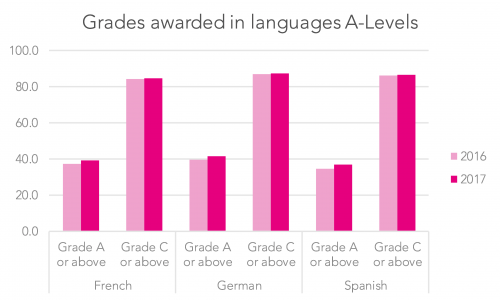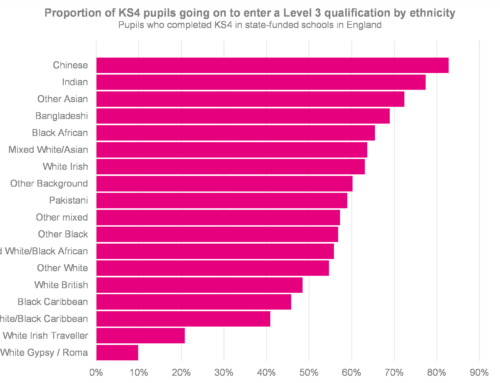We looked at some of the main A-Level results trends this morning, and separately we have looked at how results changed in subjects that have been reformed (in brief: attainment fell slightly).
But there are a couple of other interesting trends in grade distributions to be drawn out.
Some specific subjects are seeing quite large changes in grade distributions
This chart compares the picture in 2011, 2014 and 2017 – looking at the proportion of entrants achieving A*-B grades in different subjects.
In certain subjects – PE, law, sociology – the proportion reaching this standard was notably higher in 2017 than in earlier years.
Conversely, biology, chemistry, economics and French all had proportions of young people achieving a grade B or higher that were some way lower in 2017 then 2011.
(The subjects at the far right of the chart, with extremely high A*-B rates are further maths and other modern languages.)
But, while these trends might for some raise questions about whether certain subjects have got easier, the starting point has got to be to think that the changes are the result of differences in the ability mix of those entering these subjects.
Under its comparable outcomes policy, unless there is other evidence that grade distributions need to change, the exams regulator, Ofqual, requires the spread of grades handed out in a particular subject to be tied to the earlier GCSE attainment of the candidates entering that subject, and has done so at A-Level since 2010.
There is evidence of the 1% A-grade uplift that Ofqual requested in certain languages
Earlier this year, Ofqual carried out research that found that non-native speakers were penalised in certain language A-Levels, due to the fact that they were effectively competing for the top grades against native speakers.
In response, it announced that it would be instructing exam boards to hand out 1% more A-grades in French, German and Spanish [PDF].
So, can we see evidence of this in this year’s results?
As the chart below shows, the proportion of students achieving an A or A* went up in all three subjects – and in fact went up by more than 1%[1].
In French, the A*-A rate increased by 1.7 percentage points, while the corresponding increases were 1.8 percentage points and 2.5 percentage points for German and Spanish. (Interestingly, the number of entries were down in French and German, but up in Spanish.)
This doesn’t mean that the exam boards were more generous than they needed to be, though. It is again likely to be to do with a change in the mix of pupils taking these subjects – coupled with an increase in the number of A-grades available, at Ofqual’s direction.
Want to receive other results day blogposts by email? Sign up to our mailing list to get notifications about new blogposts, or to receive our half-termly newsletter
1. A*-C rates also nudged up in all three subjects. For those keen to reconcile the trends shown in the two different charts in this post: compared to 2011, the proportion of young people getting an A* was some way higher in 2017, but still a little lower at A*-A, and some way lower at all thresholds below that.







Leave A Comment